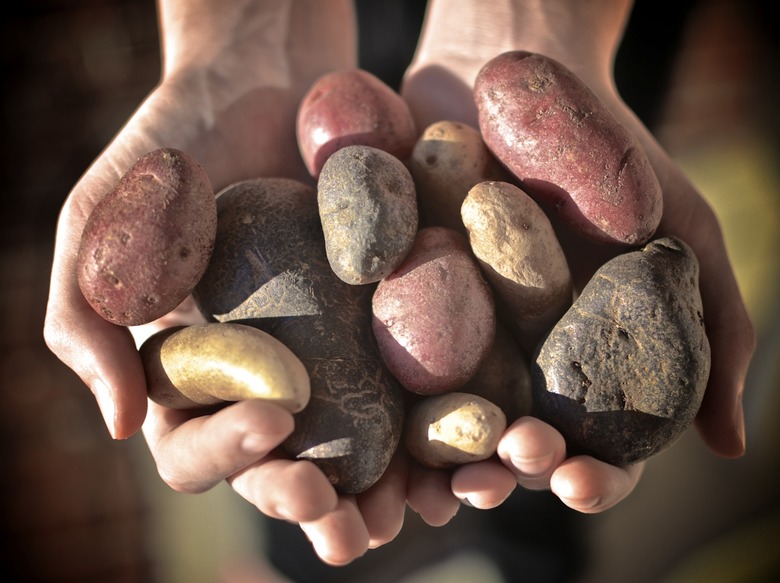How To Grow Fingerling Potatoes In A Container
Thanks to the ease of container gardening, you don't even need a garden to grow a bumper crop of elegant, delicious fingerling potatoes (Solanum tuberosum).
Thanks to the ease of container gardening, you don't even need a garden to grow a bumper crop of elegant, delicious fingerling potatoes (Solanum tuberosum). These small, finger-shaped potatoes typically take 90 to 110 days to mature, and they grow well in soil temperatures ranging from 45 to 50 degrees Fahrenheit, making them ideal for early- or late-season gardening. Place the container-grown fingerlings in a spot that receives direct sunlight for six hours or longer.
Choosing a Container
You can use nearly any type of container to grow fingerling potatoes, including barrels, garbage cans, terracotta or plastic planters, or commercially available potato growing bags, which can be found online or at garden centers.
Drainage and container size are two of the most important factors to keep in mind while choosing a planter. If the container lacks drainage holes or only has one hole, drill at least three to five 1/4-inch holes on the bottom to prevent soggy conditions. Allow 2 to 3 gallons of planter space for every fingerling potato you plan to plant. If you intend to plant three or four potatoes, select a 15-gallon container. If you're only planting one, a smaller container may suffice.
- Thanks to the ease of container gardening, you don't even need a garden to grow a bumper crop of elegant, delicious fingerling potatoes (Solanum tuberosum).
Selecting Varieties
Growing potatoes from fingerling potatoes purchased from the grocery store typically yields disappointing results because the potatoes are treated with a substance designed to retard sprouting. Instead, buy certified disease-free fingerling potato seeds from a local nursery or from a garden catalog.
Many varieties of fingerling potatoes grow well in containers, including "Russian Banana," a variety with 1- to 3-inch potatoes with yellow skin and yellow waxy, moist flesh. "Swedish Peanut," which yields tubers that grow 1 to 2/1/2 inches long, has yellow, nutty-flavored flesh. For show-stopping color, try growing "Purple Peruvian," which grows 3/4- to 2-inch potatoes with purple flesh and skin.
Planting Fingerlings
Prepare the fingerling seeds by cutting tubers into small 1-ounce rounds with at least two eyes on each piece. Choose a high quality, soil-less potting mix to reduce exposing the fingerling potatoes to the diseases and pests that naturally occur in garden soil.
- Growing potatoes from fingerling potatoes purchased from the grocery store typically yields disappointing results because the potatoes are treated with a substance designed to retard sprouting.
- For show-stopping color, try growing "Purple Peruvian," which grows 3/4- to 2-inch potatoes with purple flesh and skin.
Place 3 to 4 inches of the potting mix on the bottom of the container. Mix in two handfuls of organic starter fertilizer and arrange the seed pieces in the container. According to the National Gardening Association, fingerling potato plants generally grow larger and need extra room between seeds than other potatoes. Allow approximately **18 inches of space between the seed pieces.** Cover the seeds with another 4 to 6 inches of soil, lightly tamp it down and water the container thoroughly.
Caring for Plants
Water the container regularly, adding at least 1 inch to the container weekly. Feel the potting mix every few days, and add water as needed to maintain evenly moist — but not wet or soggy — soil. As the young potato plants grow, hill them by adding enough soil or compost around the seedlings so that only 3 inches of the plant shows.
- Place 3 to 4 inches of the potting mix on the bottom of the container.
- Cover the seeds with another 4 to 6 inches of soil, lightly tamp it down and water the container thoroughly.
Fertilize the plants once every month with an organic fertilizer formulated for vegetables. Blend approximately 2 tablespoons of the fertilizer for every 1 square foot of planting space into the top 1 to 3 inches of potting mix. Avoid overhead watering and check the plants once a week for signs of a Colorado potato beetle infestation, heralded most commonly by the presence of orange eggs located on the leaves' undersides. Remove and crush the eggs. Spray the leaves of the plant with Bacillus thuringiensis san diego, a food-safe insecticide, to kill larvae.
References
- 3-Step Vegetable Gardening; Steve Mercer and Sally Roth
- The Vegetable Gardener's Container Bible; Edward C. Smith
- The Beginner's Guide to Growing Heirloom Vegetables; Marie Iannotti
- University of California Master Gardeners: Potatoes Are Easy and Fun to Grow in Containers
- National Gardeners Association: Fingerling Potatoes
- Purdue Extension: Container and Raised Bed Gardening
- Gardeners Supply Co.: Container Gardens: Growing Vegetables in Pots and Planters
